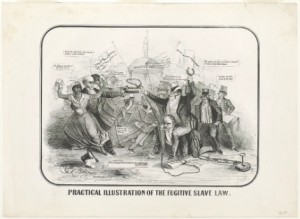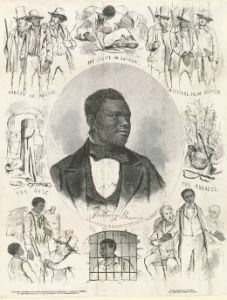Brandyn Winn
Interpreting US History Snapshot Essay
Professor Leanne White
2/4/19
Fugitive Slave Act
 .
. 
Shortly after the U.S. came together to revolt against Great Britain and gain its independence, the nation is already beginning to divide once again. This time it isn’t over taxes but instead it’ll be over the abolishment of the Institution of Slavery. In the same Declaration of Independence (U.S. 1776) that was sent by this nation to Great Britain it states, “We hold these truths to be self-evident, that all men are created equal, that they are endowed by their Creator with certain unalienable Rights, that among these are Life, Liberty and the pursuit of Happiness”, and it’s only a matter of time before people start to point out the hypocrisy of our government by allowing the Institution of Slavery to continue to exist. With the North moving towards a more industrial economy that pays workers instead of using slaves and the South still heavily relying on slave labor to keep their agricultural economy strong, the two regions begin to butt heads very hard. The Fugitive Slave Act was a failed attempt by the Federal government to make a compromise between the North and South in order to preserve the newly formed union.
The Federal Government was still in its beginning stages and didn’t want to upset half of its nation by outright emancipating slaves all at once, so instead it let the states decide whether they wanted to be a slave state or a free state. With most Northern States choosing to be free states and the South being predominantly slave states this started a trend of slaves attempting to reach the North to gain freedom. In the years leading up to 1793 Southern politicians, which were often slave owners as well, became upset with losing their slaves so they pushed Congress to make laws to aid them in getting their slaves back, which lead to the passing of the Fugitive Slave Act of 1793 (Fugitive Slave Law of 1793). The Fugitive Slave Law of 1793 stated that if anyone from a slave state declares a person as a fugitive slave and can provide the proper proof or paperwork in front of a judge then he can legally return the fugitive back to his/her owner in the South. It also states that anyone aiding or housing the slave on his escape is guilty of treason and can face up to a year in prison and a $500 fine, so essentially this act was threatening Northerners who didn’t aid in the return of slaves back to the South. This act didn’t change until The Fugitive Slave Law of 1850 was passed by Congress. The Fugitive Slave Act of 1850 made it so fugitive slave catchers would no longer go before state judges when they catch a fugitive, but instead they would go before a more superior court ran by the Federal Government. This act was passed because Northern states’ court systems were beginning to neglect the act passed in 1793 in their fights for abolishment. It was only a matter of time before Northerners spoke up about their disagreement with the acts(Fugitive Slave Law of 1850). A woman from Massachusetts by the name of L. Maria Child even spoke out about the injustices of the act. She wrote about the brutal ways that slaves were hunted down by saying, “If they attempt to run away from us, blood-hounds shall tear their flesh from their bones, and man who sees them may shoot them down like mad dogs.” (Childs 4) The Fugitive Slave Law stayed in effect all the way up until the Confiscation Act was enacted by Congress in 1861 but by that point the nation had already been divided and it was now heading towards a major internal conflict later known as the Civil War.(Confiscation act of 1861)
In conclusion, the abolishment of the Institution of slavery was a long and rigorous process. Pro-Slavery and Anti-Slavery forces battled for nearly 100 years over the issue, and the Fugitive Slave Act was just a tiny piece of the conflict, even though it affected the lives of so many.

Drawing shows fugitive slave Anthony Burns. His arrest and trial under the Fugitive Slave Act of 1850 triggered a string of abolitionist riots and protests in the Spring of 1854. The center of the drawing shows Anthony Burns himself, and on the outer edges are events from his life.These include (clockwise from lower left): the sale of the youthful Burns at auction, a whipping post with bales of cotton, his arrest in Boston on May 24, 1854, his escape from Richmond on shipboard, his departure from Boston escorted by federal marshals and troops, Burns’s “address” (to the court?), and finally Burns in prison.